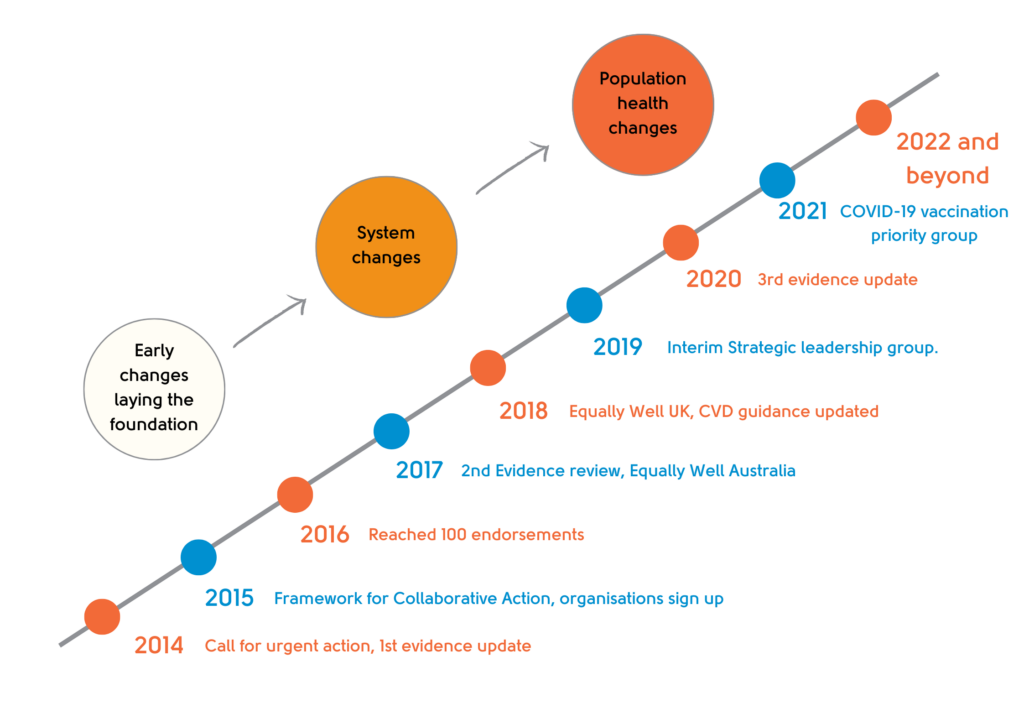The beginnings of Equally Well
A group of mental health and addiction leaders and advocates from the non-government sector were discussing the untimely deaths of many people in contact with mental health and addiction services. Kay Fletcher, then CE of Comcare Trust and Platform Board member, declared that this is not acceptable!
In that moment, the Board agreed, we must look at what we as mental health and addiction NGO services can do, and we must work with others.
Calls were made. The Wise Group were asked if they would gift some time from their strategic advisor, Helen Lockett. Robyn Shearer, then CE of Te Pou was also asked if Te Pou could provide some researcher time, to bring some of the published evidence together.
A partnership between Platform and Te Pou began which was to seed the Equally Well movement, and develop a whole new set of partners connected by the common aim of addressing physical health inequities, and an urgent call to action.
Together, a small team started reaching and talking to partners across and beyond the mental health and addiction sector and making ‘new friends’.
In 2014, Te Pou published the first evidence review, with subsequent updates in 2017 and 2020. The figures showing the stark inequities were widely disseminated and the consensus position paper was launched by a group of eight organisations – Matua Raki Consumer Leadership group, New Zealand Medical Association, New Zealand Nurses Association, Ngā Hau e Whā national service user group, Platform Trust Atamira, RANZCP Tu Te Akaaka Roa, Te Ao Māramatanga NZ College of Mental Health Nurses and Te Pou. The partners called for urgent collective action and asked organisations to join the collaborative.
By December 2016, Equally Well Aotearoa had 100 organisations who pledged their commitment to taking action in their spheres of influence. Two years later Australia and England had started their own Equally Well collaboratives.

Building and sustaining the Equally Well movement – a timeline of key activities
The beginnings of
Ngā Waka o Matariki
In 2019 the Equally Well strategic leadership group agreed there was a need to strengthen how Equally Well worked to address the inequities faced by Māori. They invited tāngata whaiora Māori, Tui Taurua, Reena Kainamu, and Kahurangi Tibble-Ferguson, to join the rōpū which led to the development of Ngā Waka o Matariki, the Equally Well Māori Health Strategy 2020 to 2025.
Together as a team Tui, Reena and Kahurangi began to korero about the Equally Well Maori Strategy to discuss future movement for the Strategic Leadership ropu. The korero began in June (2020).
Ngā Waka is about each collaborative/collective on their own waka, understanding in unity we need to work together for the good of all tangata whaiora. He tangata, he tangata, he tangata.
June is the time when the nine stars of Matariki come into our nightly vision. This is a significant time of the year for Maori as identified in the Maori calendar/Maramataka, our New Year. At this time historically our Rangatira/leaders waananga; come together to talk about important issues that affect our people.
The whakatauaki without design had nine verses, which also reflect the nine stars of Matariki. The two fitted together with ease. Below Tui explains the beginnings of this whakatauaki.